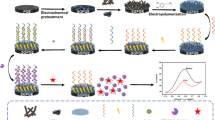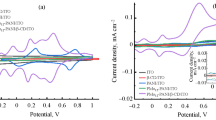Abstract
A new strategy for enhancing the photoelectric activity of poly(5-formylindole) (P5FIn) was developed by introducing the inorganic semiconductor material (NiO) to form organic-inorganic heterojunctions. P5FIn/NiO heterojunctions were firstly prepared by combining hydrothermal synthesis and electrochemical polymerization. Due to the synergistic effect between P5FIn and NiO, the photoelectrochemical (PEC) performance of this heterojunction was significantly enhanced compared to pure P5FIn and NiO. The reason for the enhanced PEC performance is mainly attributed to the increased visible light utilization and the bandgap matching effect of the P5FIn/NiO heterojunctions. Based on the prepared P5FIn/NiO heterojunctions, a novel PEC sensor for aflatoxin B1 (AFB1) detection was also constructed with a wide linear range of 0.005–50 ng mL−1 and a limit of detection (LOD) of 0.0015 ng mL−1. Moreover, this constructed PEC sensor also had good stability, reproducibility, selectivity, and satisfactory actual sample detection ability. This strategy may inspire more design and application of high-performance photoelectric active material based on inorganic semiconductor and organic conducting polymer heterojunctions.

Graphical abstract






Similar content being viewed by others
References
Song Z, Fan G-C, Li Z, Gao F, Luo X (2018) Universal design of selectivity-enhanced photoelectrochemical enzyme sensor: integrating photoanode with biocathode. Anal Chem 90(18):10681–10687
Lv S, Li Y, Zhang K, Lin Z, Tang D (2017) Carbon dots/g-C3N4 nanoheterostructures-based signal-generation tags for photoelectrochemical immunoassay of cancer biomarkers coupling with copper nanoclusters. ACS Appl Mater Inter 9(44):38336–38343
Zheng Y-N, Liang W-B, Xiong C-Y, Zhuo Y, Chai Y-Q, Yuan R (2017) Universal ratiometric photoelectrochemical bioassay with target-nucleotide transduction-amplification and electron-transfer tunneling distance regulation strategies for ultrasensitive determination of microRNA in cells. Anal Chem 89(17):9445–9451
Wang G-L, Yuan F, Gu T, Dong Y, Wang Q, Zhao W-W (2018) Enzyme-initiated quinone-chitosan conjugation chemistry: toward a general in situ strategy for high-throughput photoelectrochemical enzymatic bioanalysis. Anal Chem 90(3):1492–1497
Wang Y, Wang P, Wu Y, Di J (2018) A cathodic “signal-on” photoelectrochemical sensor for Hg2+ detection based on ion-exchange with ZnS quantum dots. Sensor Actuat B-Chem 254:910–915
Liu S, He P, Hussain S, Lu H, Zhou X, Lv F, Liu L, Dai Z, Wang S (2018) Conjugated polymer-based photoelectrochemical cytosensor with turn-on enable signal for sensitive cell detection. ACS Appl Mater Interfaces 10(7):6618–6623
Zhao W-W, Xu J-J, Chen H-Y (2018) Photoelectrochemical immunoassays. Anal Chem 90(1):615–627
Ibrahim I, Lim HN, Zawawi RM, Tajudin AA, Ng YH, Guo H, Huang NM (2018) A review on visible-light induced photoelectrochemical sensors based on CdS nanoparticles. J Mater Chem B 6(28):4551–4568
Peng J, Huang Q, Zhuge W, Liu Y, Zhang C, Yang W, Xiang G (2018) Blue-light photoelectrochemical sensor based on nickel tetra-amined phthalocyanine-graphene oxide covalent compound for ultrasensitive detection of erythromycin. Biosens Bioelectron 106:212–218
Wang H, Yin H, Huang H, Li K, Zhou Y, Waterhouse GI, Lin H, Ai S (2018) Dual-signal amplified photoelectrochemical biosensor for detection of N6-methyladenosine based on BiVO4-110-TiO2 heterojunction, Ag+-mediated cytosine pairs. Biosens Bioelectron 108:89–96
Dai W-X, Zhang L, Zhao W-W, Yu X-D, Xu J-J, Chen H-Y (2017) Hybrid PbS quantum dot/nanoporous NiO film nanostructure: preparation, characterization, and application for a self-powered cathodic photoelectrochemical biosensor. Anal Chem 89(15):8070–8078
Otep S, Michinobu T, Zhang Q (2019) Pure organic semiconductor-based photoelectrodes for water splitting. Solar RRL:1900395
Gu P, Wang Z, Xiao F, Lin Z, Song R, Xu Q, Lu J, Liu B, Zhang Q (2017) An ambipolar azaacene as a stable photocathode for metal-free light-driven water reduction. Mater Chem Front 1(3):495–498
Nie G, Tang Y, Zhang B, Wang Y, Guo Q (2018) Label-free photoelectrochemical immunosensing platform for detection of carcinoembryonic antigen through photoactive conducting poly (5-formylindole) nanocomposite. Biosens Bioelectron 116:60–66
Zhang L, Ruan Y-F, Liang Y-Y, Zhao W-W, Yu X-D, Xu J-J, Chen H-Y (2018) Bismuth oxyiodide couples with glucose oxidase: a special synergized dual-catalysis mechanism for photoelectrochemical enzymatic bioanalysis. ACS Appl Mater Inter 10(4):3372–3379
Zhu J, Huo X, Liu X, Ju H (2016) Gold nanoparticles deposited polyaniline-TiO2 nanotube for surface plasmon resonance enhanced photoelectrochemical biosensing. ACS Appl Mater Interfaces 8(1):341–349
Feng J, Li Y, Gao Z, Lv H, Zhang X, Dong Y, Wang P, Fan D, Wei Q (2018) A competitive-type photoelectrochemical immunosensor for aflatoxin B1 detection based on flower-like WO3 as matrix and Ag2S-enhanced BiVO4 for signal amplification. Sensor Actuat B-Chem 270:104–111
Wang C, Qian J, An K, Ren C, Lu X, Hao N, Liu Q, Li H, Huang X, Wang K (2018) Fabrication of magnetically assembled aptasensing device for label-free determination of aflatoxin B1 based on EIS. Biosens Bioelectron 108:69–75
Nie G, Wang Y, Tang Y, Zhao D, Guo Q (2018) A graphene quantum dots based electrochemiluminescence immunosensor for carcinoembryonic antigen detection using poly (5-formylindole)/reduced graphene oxide nanocomposite. Biosens Bioelectron 101:123–128
Li R, Zhang Y, Tu W, Dai Z (2017) Photoelectrochemical bioanalysis platform for cells monitoring based on dual signal amplification using in situ generation of electron acceptor coupled with heterojunction. ACS Appl Mater Interfaces 9(27):22289–22297
Xing W, Li F, Yan Z, Lu G (2014) Synthesis and electrochemical properties of mesoporous nickel oxide. J Power Sources 134(2):324–330
Nie G, Zhou L, Yang H (2011) Electrosynthesis of a new polyindole derivative obtained from 5-formylindole and its electrochromic properties. J Mater Chem 21(36):13873–13880
Raj R, Ragupathy P, Mohan S (2015) Remarkable capacitive behavior of a Co3O4-polyindole composite as electrode material for supercapacitor applications. J Mater Chem A 3:24338–24348
Jayababu N, Poloju M, Shruthi J, Reddy MVR (2019) Synthesis of ZnO/NiO nanocomposites for the rapid detection of ammonia at room temperature. Mat Sci Semicon Proc 102:104591
Lin Y, Zhou Q, Tang D, Niessner R, Knopp D (2017) Signal-on photoelectrochemical immunoassay for aflatoxin B1 based on enzymatic product-etching MnO2 nanosheets for dissociation of carbon dots. Anal Chem 89(10):5637–5645
Abnous K, Danesh NM, Alibolandi M, Ramezani M, Emrani AS, Zolfaghari R, Taghdisi SM (2017) A new amplified π-shape electrochemical aptasensor for ultrasensitive detection of aflatoxin B1. Biosens Bioelectron 94:374–379
Krittayavathananon A, Sawangphruk M (2017) Impedimetric sensor of ss-HSDNA/reduced graphene oxide aerogel electrode toward aflatoxin B1 detection: effects of redox mediator charges and hydrodynamic diffusion. Anal Chem 89(24):13283–13289
Zhang B, Lu Y, Yang C, Guo Q, Nie G (2019) Simple “signal-on” photoelectrochemical aptasensor for ultrasensitive detecting AFB1 based on electrochemically reduced graphene oxide/poly (5-formylindole)/Au nanocomposites. Biosens Bioelectron 134:42–48
Goud KY, Catanante G, Hayat A, Satyanarayana M, Gobi KV, Marty JL (2016) Disposable and portable electrochemical aptasensor for label free detection of aflatoxin B1 in alcoholic beverages. Sensor Actuat B-Chem 235:466–473
Shim WB, Mun H, Joung HA, Ofori JA, Chung DH, Kim MG (2014) Chemiluminescence competitive aptamer assay for the detection of aflatoxin B1 in corn samples. Food Control 36(1):30–35
Wang Y, Zhao G, Li X, Liu L, Cao W, Wei Q (2018) Electrochemiluminescent competitive immunosensor based on polyethyleneimine capped SiO2 nanomaterials as labels to release Ru (bpy)32+ fixed in 3D cu/Ni oxalate for the detection of aflatoxin B1. Biosens Bioelectron 101:290–296
Liu Y, Yan T, Li Y, Cao W, Pang X, Wu D, Wei Q (2015) A simple label-free photoelectrochemical immunosensor for highly sensitive detection of aflatoxin B1 based on CdS-Fe3O4 magnetic nanocomposites. RSC Adv 5(25):19581–19586
Funding
This work was financially supported by the National Natural Science Foundation of China (51973102), Natural Science Foundation of Shandong (ZR2019MB067), and Talent Fund of QUST (2019).
Author information
Authors and Affiliations
Corresponding authors
Ethics declarations
Conflict of interest
The authors declare that they have no conflict of interest.
Additional information
Publisher’s note
Springer Nature remains neutral with regard to jurisdictional claims in published maps and institutional affiliations.
Electronic supplementary material
ESM 1
(DOC 404 kb)
Rights and permissions
About this article
Cite this article
Lu, Y., Zhang, B., Tian, Y. et al. An enhanced photoelectrochemical sensor for aflatoxin B1 detection based on organic-inorganic heterojunction nanomaterial: poly(5-formylindole)/NiO. Microchim Acta 187, 467 (2020). https://doi.org/10.1007/s00604-020-04439-9
Received:
Accepted:
Published:
DOI: https://doi.org/10.1007/s00604-020-04439-9




